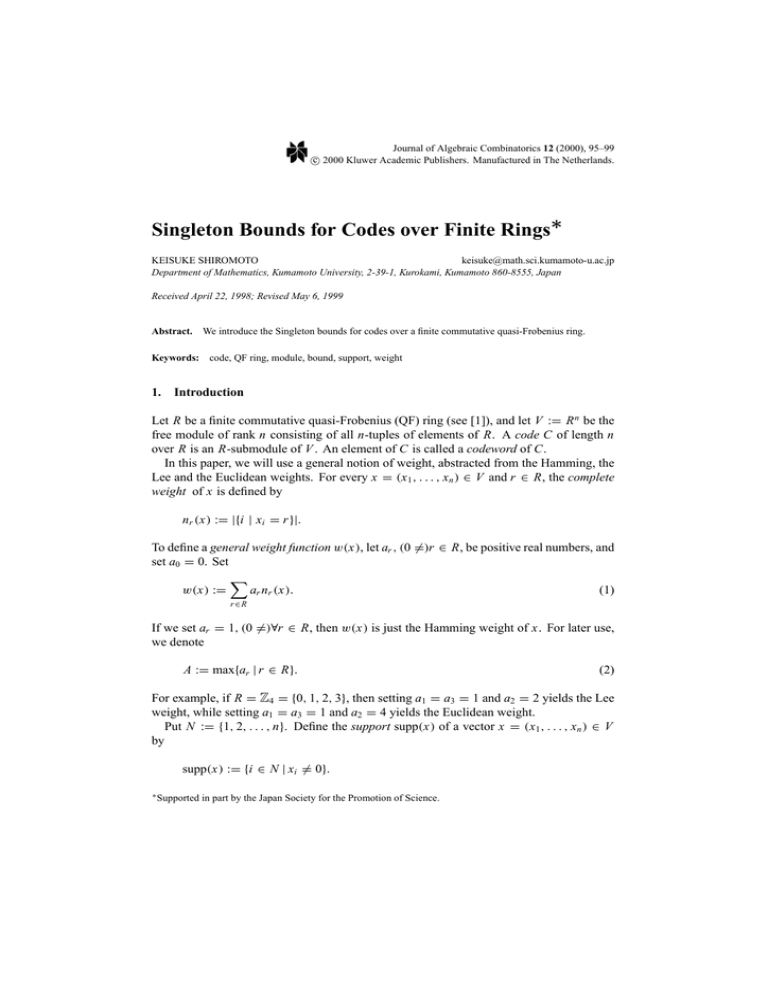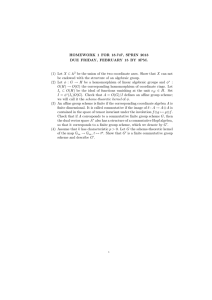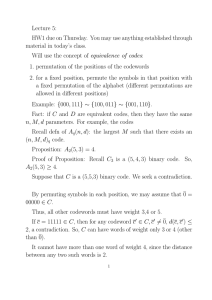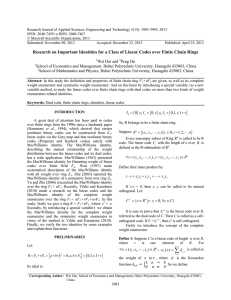∗
advertisement

Journal of Algebraic Combinatorics 12 (2000), 95–99
c 2000 Kluwer Academic Publishers. Manufactured in The Netherlands.
°
Singleton Bounds for Codes over Finite Rings∗
KEISUKE SHIROMOTO
keisuke@math.sci.kumamoto-u.ac.jp
Department of Mathematics, Kumamoto University, 2-39-1, Kurokami, Kumamoto 860-8555, Japan
Received April 22, 1998; Revised May 6, 1999
Abstract.
We introduce the Singleton bounds for codes over a finite commutative quasi-Frobenius ring.
Keywords: code, QF ring, module, bound, support, weight
1.
Introduction
Let R be a finite commutative quasi-Frobenius (QF) ring (see [1]), and let V := R n be the
free module of rank n consisting of all n-tuples of elements of R. A code C of length n
over R is an R-submodule of V . An element of C is called a codeword of C.
In this paper, we will use a general notion of weight, abstracted from the Hamming, the
Lee and the Euclidean weights. For every x = (x 1 , . . . , xn ) ∈ V and r ∈ R, the complete
weight of x is defined by
n r (x) := |{i | xi = r }|.
To define a general weight function w(x), let ar , (0 6=)r ∈ R, be positive real numbers, and
set a0 = 0. Set
X
ar n r (x).
(1)
w(x) :=
r ∈R
If we set ar = 1, (0 6=)∀r ∈ R, then w(x) is just the Hamming weight of x. For later use,
we denote
A := max{ar | r ∈ R}.
(2)
For example, if R = Z4 = {0, 1, 2, 3}, then setting a1 = a3 = 1 and a2 = 2 yields the Lee
weight, while setting a1 = a3 = 1 and a2 = 4 yields the Euclidean weight.
Put N := {1, 2, . . . , n}. Define the support supp(x) of a vector x = (x1 , . . . , xn ) ∈ V
by
supp(x) := {i ∈ N | xi 6= 0}.
∗ Supported
in part by the Japan Society for the Promotion of Science.
96
SHIROMOTO
The minimum weight of a code C, denoted by d, is
d := min{w(x) | (0 6=)x ∈ C}.
We make the important (and elementary) observation that
w(x) ≤ A|supp(x)|.
(3)
The inner product of vectors x = (x1 , . . . , xn ), y = (y1 , . . . , yn ) ∈ V is defined by
hx, yi = x1 y1 + · · · + xn yn .
The dual code of C is defined by
C ⊥ := {y ∈ V | hx, yi = 0
(∀x ∈ C)}.
The following proposition is well-known as the Singleton bound (see [4]).
Proposition 1 Let C be a linear [n, k, d]-code over GF(q), where d is the minimum
Hamming weight of C. Then,
d ≤ n − k + 1.
The main purpose of this paper is to find a similar bound for the minimum weight of a
general weight function w(x) over R.
2.
Singleton bound
For a submodule D of V and a subset M ⊆ N = {1, 2, . . . , n}, let
D(M) := {x ∈ D | supp(x) ⊆ M},
D ∗ := Hom R (D, R).
Clearly D(M) = D ∩ V (M) is a submodule of V , and |V (M)| = |R||M| . It is also the case
that |D| = |D ∗ | for any submodule of V . The following lemma is essential. (There is a
similar result over GF(q) in [6]).
Lemma 1 Let C be a code of length n over R and M ⊆ N . Then there is an exact
sequence of R-modules:
inc
f
res
0 → C ⊥ (M) → V (M) → C ∗ → C(N − M)∗ → 0,
where the maps inc, res denote the inclusion map, restriction map, respectively, and the
map f is defined by
f : y 7→ ( ŷ : x 7→ hx, yi).
SINGLETON BOUNDS FOR CODES OVER FINITE RINGS
97
Proof: The exactness of the sequence at C ⊥ (M) and at V (M) is clear. That the map
res is surjective follows from R being an injective module over itself (the meaning of R
being QF).
Clearly we note that Im f ⊆ ker(res). Conversely, if we take any λ ∈ ker(res), then
λ(x) = 0 (∀x ∈ C(N − M)).
Note that V → C ∗ ; v 7→ v̂ is surjective, so there exists y ∈ V with λ = ŷ. For any
x ∈ C(N − M), hx, yi = 0, so that,
y ∈ (C(N − M))⊥ = (C ∩ V (N − M))⊥
= C ⊥ + V (N − M)⊥ = C ⊥ + V (M).
Since ẑ = 0 for any z ∈ C ⊥ , we have
ker(res) ⊆ Im f.
Thus the sequence is also exact at C ∗ , and the lemma follows.
2
We remark that we can prove the MacWilliams identity for codes over Z4 ([3]) by using
Lemma 1 (there are similar results over GF(q) in [5] and [6]).
Using the above lemma, we establish the Singleton bound for a general weight function
over R.
Theorem 1 Let C be a code of length n over a finite commutative QF ring R. Let w(x)
be a general weight function on C, as in (1), and with maximum ar -value A, as in (2).
Suppose the minimum weight of w(x) on C is d. Then
·
¸
d −1
≤ n − log|R| |C|,
A
where [b] is the integer part of b.
Proof:
By Lemma 1, we have
|C| · |C ⊥ (N − M̃)| = |V (N − M̃)| · |C( M̃)|,
], then |C( M̃)| = 1
where M̃ = N − M. If we take a subset M of N with | M̃| = [ d−1
A
by (3). Since we always have |C ⊥ (N − M̃)| ≥ 1, we see that
|C| ≤ |V (N − M̃)| = |R||N − M̃| .
Hence the theorem follows.
2
98
3.
SHIROMOTO
An application to codes over Zl
The ring R = Zl is a good example of a finite commutative QF ring. Let k := [l/2], and
regard Zl as the set {0, ±1, . . . , ±k} (with k = −k, when l = 2k is even). On codes over
Zl , there are three special weight functions:
1. the Hamming weight, where each ai = 1, i 6= 0,
2. the Lee weight, where ai = |i|, and
3. the Euclidean weight, where ai = |i|2 .
Denote the minimum weight of a code C with respect to these three weights by d H , d L and
d E , respectively. It is clear that the maximum ar -value A is 1, k and k 2 , respectively. The
next result follows immediately from Theorem 1.
Theorem 2 Using the above notation for a code C of length n over Zl , there are the
following bounds on minimum weights:
d H ≤ n − logl |C| + 1,
¸
dL − 1
≤ n − logl |C|,
k
¸
·
dE − 1
≤ n − logl |C|.
k2
·
The Gray map φ : Z4 → Z22 is defined by φ(0) = 00, φ(1) = 01, φ(2) = 11, and
φ(3) = 10. It is well-known that φ is a weight-preserving map from (Zn4 , Lee weight)
to (Z2n
2 , Hamming weight) (see [2]). Using the above theorem, we have the Singleton
bound for certain binary nonlinear codes.
Corollary 1 If a binary nonlinear (2n, M, d)-code B, where M := |B| and d is the
minimum Hamming weight of B, is the Gray map image of a code C of length n over Z4 ,
then
¸
·
d −1
≤ n − log4 M.
2
Proof: Since M = |C| and d is also the minimum Lee weight of C, the corollary follows
from Theorem 2.
2
Acknowledgment
The author would like to thank the referee for his helpful advice on QF rings and general
weight functions and other helpful suggestions. The author would like to thank adviser
Professor Tomoyuki Yoshida for his helpful suggestions and Dr. Masaaki Harada for his
helpful comments on codes over Z4 .
SINGLETON BOUNDS FOR CODES OVER FINITE RINGS
99
References
1. C.W. Curtis and I. Reiner, Representation Theory of Finite Groups and Associative Algebras, Interscience
Publishers, New York, 1962.
2. A.R. Hammons, P.V. Kumar, A.R. Calderbank, N.J.A. Sloane, and P. Solé, “The Z4 -linearity of Kerdock,
Preparata, Goethals, and related codes,” IEEE Trans. Inform. Theory 40 (1994), 301–319.
3. M. Klemm, “Über die Identität von MacWilliams für die Gewichtsfunktion von Codes,” Arch. Math. 49 (1987),
400–406.
4. F.J. MacWilliams and N.J.A. Sloane, The Theory of Error-Correcting Codes, North Holland, Amsterdam,
1977.
5. K. Shiromoto, “A new MacWilliams type identity for linear codes,” Hokkaido Math. J. 25 (1996), 651–656.
6. T. Yoshida, “MacWilliams identities for linear codes with group action,” Kumamoto Math. J. 6 (1993), 29–45.


![MA1124 Assignment5 [due Monday 16 February, 2015]](http://s2.studylib.net/store/data/010730348_1-77b9a672d3722b3831a1e52597d5a881-300x300.png)

